joelchan's working notes
Powered by 🌱Roam Garden@tsengRoleTimingAnalogical2008 for [[QUE - How might domain distance modulate the effects of analogies on creative output?]] | near analogies suprisingly novel; quant/diversity benefit for far analogies (curated) only when encountered with open goal (not before)
just one experiment, but a few sub-analyses
interested in how impact of stimuli varies by timing (relative to part of design session)
methods notes
Problem: generate conceptual designs for time-keeping devices using only a provided list of household objects, such as adhesive tape, twine, tupperware containers, box of matches, thermometer, etc.
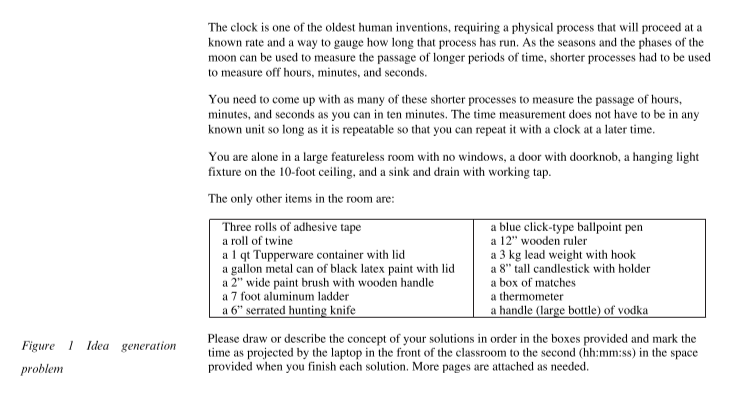 (p. 207)
(p. 207)
So a spin on classic alternative uses task
Participants: 71 undergrad senior mechanical engineering students at a major private university
 (p. 207)
(p. 207)
Design: single factor, 4 between-subjects condition (nothing aka control vs. vs. surface similar before problem (clocks) vs. surface dissimilar (water meter, heart rate monitor, cassette tape recorded) before problem vs. surface dissimilar during problem (after filler task). All stimuli text only.
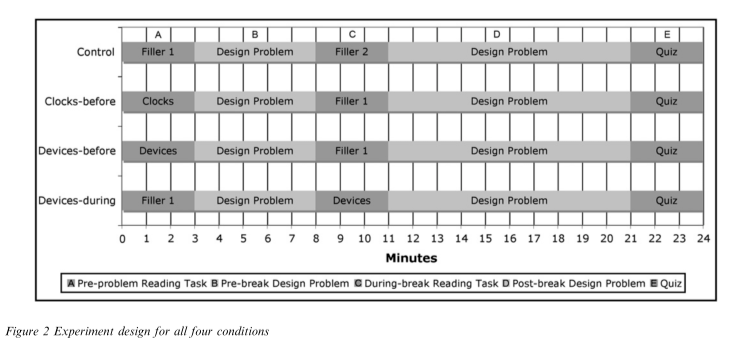 (p. 208)
(p. 208)
Irrelevant for filler task was three short summaries of current news stories
Near devices: grandfather clock, windup clock, and quartz wristwatch
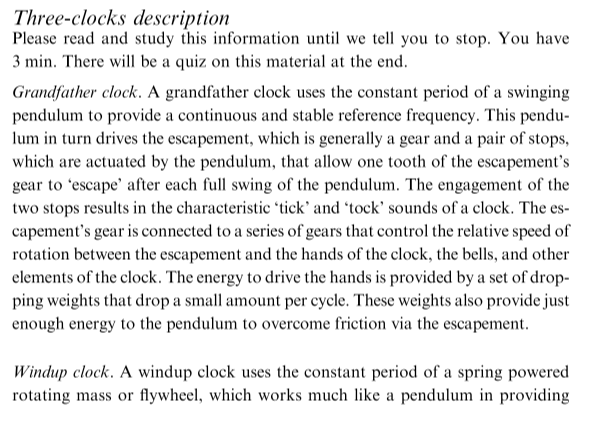 (p. 218)
(p. 218)
 (p. 219)
(p. 219)
Distant devices: heart rate monitor, cassette tape deck, and water meter
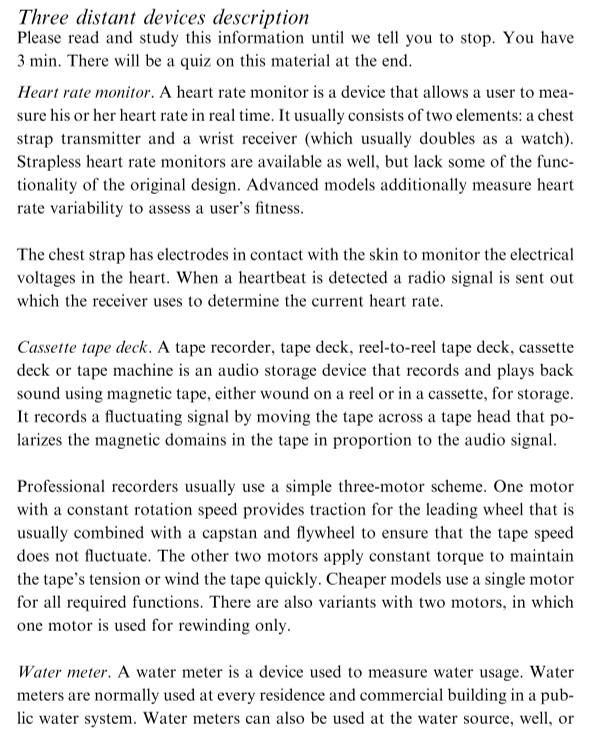 (p. 219)
(p. 219)
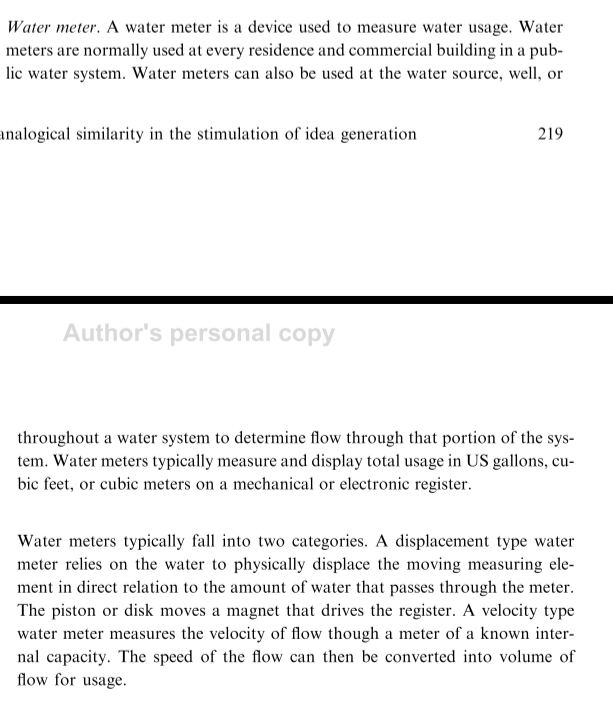 (p. 220)
(p. 220)
Procedure: generally, start with 3-min reading task (material depends on condition), then 5 mins to work on problem, then 3 min "filler task" (where material again depends on condition), and then final 10 mins to work on problem (for a total of ~21 mins). All participants instructed not to repeat previous solutions.
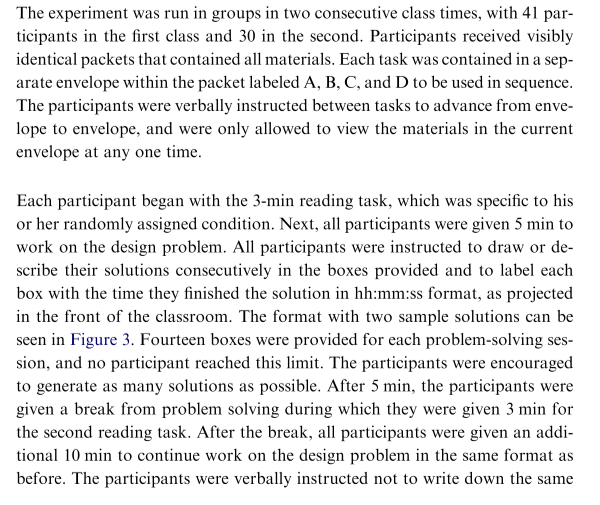 (p. 208)
(p. 208)
Dependent measures:
Total number of designs
Novelty of each solution
All functional measures relied on a functional categorization, which had two researchers independently assign one or more functional categories (from a bottom-up generated list of 16 categories) to each solution. NOTE: singular solutions (functional categories that only one person generated) were lumped together into a single "other" category, comprising 3% of solutions. inter-rater reliability was pretty good, at Cohen's K = 0.87
 (p. 209)
(p. 209)
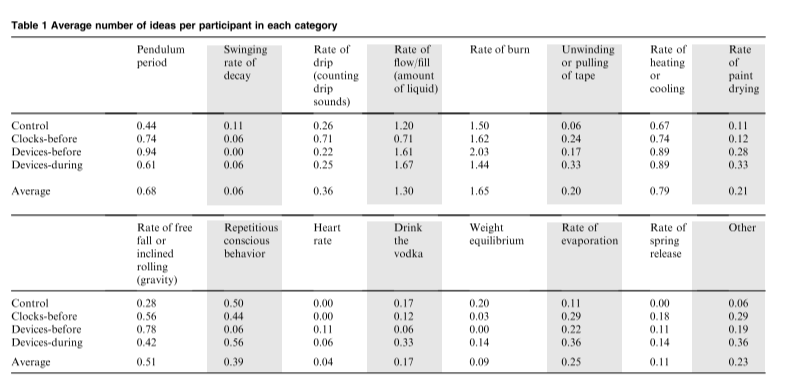 (p. 211)
(p. 211)
results:
[[EVD - Far analogies' effects on MechE students' ideation fluency and diversity were different depending on timing: more ideas (but with more functional repeats) before ideation began, vs. more functionally distinct designs after problem solving began (during a break), both compared to seeing nothing - @tsengRoleTimingAnalogical2008]]
[[EVD - Far analogies' effects on MechE students' novelty of ideas were different depending on timing: more novel ideas when seeing them after problem solving began vs. before - @tsengRoleTimingAnalogical2008]]
[[EVD - In general, MechE students' ideas when given near analogies were at least as novel, and sometimes moreso, then ideas generated with far analogies, or seeing nothing - @tsengRoleTimingAnalogical2008]]
[[EVD - Undergrad MechE students who saw near analogies (clocks) for a time-keeping problem preferred discrete (drip-based) solutions to continuous (e.g., flow/fill) solutions - @tsengRoleTimingAnalogical2008]]
this might be an example of fixation, cc @janssonDesignFixation1991 and @linseyStudyDesignFixation2010
conclusions
on the basis of these results, the authors claim that timing, and specifically open goals determine [[QUE - What factors control whether people appropriately benefit from analogies (especially far-field ones) during creative problem solving?]]. Specifically, they claim that [[CLM - People are more likely to benefit from far analogies if they encounter them while they have an open goal - @tsengRoleTimingAnalogical2008]]
this comes most from the work of @patalanoMemoryImpassesProblem1994 @patalanoOpportunisticPlanningBeing1997 and connects to the Zeigarnik effect
this finding has been replicated somewhat in our work with @siangliulueProvidingTimelyExamples2015, although it is in tension with @kulkarniEarlyRepeatedExposure2012
i think the more general claim here is that open goals can make it more likely that potentially beneficial stimuli will be noticed and processed in useful ways, even if there are normal barriers that might prevent this (such as in the case of far analogies, difficulties with mapping, etc.)
appraisal
the way the devices were described makes me wonder how they compare to encountering these devices in the wild, vs. "curated" to facilitate noticing of the analogical mapping, like in @gickSchemaInductionAnalogical1983 and @reedRoleAnalogyTransfer1974
cf. [[QUE - What factors control whether people appropriately benefit from analogies (especially far-field ones) during creative problem solving?]] and [[CLM - People are more likely to benefit from analogies if they encounter/process them with an active goal or license to use them for inspiration]]
overall, this isn't a very strong set of results. proceed with extreme caution on their own.